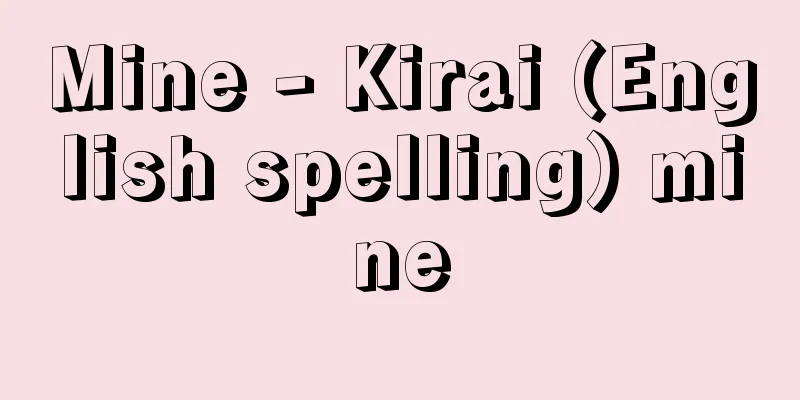Mine - Kirai (English spelling) mine

|
A weapon that is moored underwater in straits, harbors, and sea routes where enemy ships are expected to pass, or laid on the seabed in advance or drifted on the surface of the sea to destroy ships that come into contact with or approach. It is an abbreviation of mechanical torpedo, and is a typical waiting weapon like land mines. They are laid by dedicated mine-laying ships as well as surface ships, submarines, and aircraft. They are classified according to the laying method as moored, bottom-sunk, and floating, and according to the detonation method as triggered, controlled, and response. It is said that it was first used in actual combat in 1776 during the American War of Independence, when David Bushnell (1742-1824) loaded mines on his submarine "Turtle" and attached them to the bottom of a British ship. During the American Civil War, the Southern Confederacy, which had a weaker naval power, actively engaged in mine warfare. During the Russo-Japanese War (1904-1905), moored mines on both sides proved effective, and the Combined Fleet's battleships Hatsuse and Yashima were lost during the blockade of Port Arthur. The Russian Pacific Fleet's flagship Petropavlovsk and other ships were also hit by mines and sunk, and Commander Makarov was killed in action. After World War I, when submarines began to play a prominent role, mine warfare became large-scale and was used for anti-submarine operations and commerce raiding. During the First and Second World Wars, the Royal Navy set up an anti-submarine mine barrage of about 10,000 mines in the Straits of Dover, blocking the shortest route to the Atlantic for German submarines. In addition, to secure the country's maritime traffic, they also established safe routes protected by mine reefs. In the Second World War, the US military devoted 6% of the operations of its B-29 bombers to laying mines, sinking 12,000 mines at about 20 target sea areas, with the aim of attacking Japanese shipping. As a result, by the end of the war, not only ocean shipping routes but even domestic shipping routes such as the Seikan route had almost come to a halt. Mines were also used extensively in the Korean War (1950-1953) and the Vietnam War (1960-1975), during which North Korea laid mines in major ports to prevent the approach of U.S. fleets, and during the Vietnam War, the U.S. military blockaded three major ports in North Vietnam with mines to prevent them from being used. During the Iran-Iraq War (1980-1988), mines were also laid in the Persian Gulf and Red Sea, causing repeated damage to tankers and cargo ships. However, mine warfare has not been given much importance in the subsequent "war on terror." Current mines are mainly induction mines that detonate when they detect changes in magnetism, sound, or water pressure. In addition, two or more induction methods can be combined to increase the target selection ability, while a multi-reaction method is used to make it difficult to neutralize laid mines. In addition, with the development of high technology, new types of controlled mines that can be activated or deactivated remotely from surface ships or submarines have been developed, as well as the American Captor anti-submarine bottom mine, which is laid like a mine but automatically launches its built-in torpedo when it detects an enemy ship. The Soviet Union also possessed nuclear mines with nuclear warheads of 5 to 20 kilotons. For land-based anti-personnel mines, the Anti-Personnel Mine Ban Treaty came into effect in 1999, but there has been no movement regarding mines. They continue to be developed and stockpiled as a complementary weapon for the navies of each country, and the Self-Defense Forces also possess moored and bottom mines. [Tetsuo Maeda] [References] | | | | |©Shogakukan "> Conceptual diagram of various mine ignitions Source: Shogakukan Encyclopedia Nipponica About Encyclopedia Nipponica Information | Legend |
|
敵艦が通ると思われる海峡、港湾、海上交通路の水中に係維、または海底にあらかじめ沈底敷設ないし海面に漂わせて、接触したり接近する艦船を破壊する兵器。機械水雷の略称で、地雷と同じ典型的な待ち受け兵器である。専用の敷設艦のほか水上艦、潜水艦、航空機などによっても敷設されるが、敷設法からの分類により係維式、沈底式、浮流式に分かれ、起爆のさせ方により触発、管制、感応方式に区分される。初めて実戦に用いられたのは、1776年アメリカ独立戦争の際、ブッシュネルDavid Bushnell(1742―1824)が潜航艇「タートル号」に機雷を積んで英艦の艦底に取り付けたときであるとされる。南北戦争では海軍力の劣勢な南部同盟軍が積極的な機雷戦を展開した。日露戦争(1904~1905)では双方の係維機雷が威力を発揮し、旅順港封鎖戦においては連合艦隊の戦艦「初瀬」「八島」が失われ、ロシア太平洋艦隊も旗艦ペトロパブロフスクなどが触雷、沈没、マカロフ司令官が戦死している。 潜水艦の活躍が目だつようになった第一次世界大戦以降、機雷戦は大規模になり、対潜作戦や通商破壊戦にも利用されるに至った。第一次、第二次世界大戦時にイギリス海軍は、ドーバー海峡に約1万個の機雷で対潜機雷堰(たいせんきらいえん)を設置、ドイツ潜水艦の大西洋への最短路を奪った。また自国の海上交通を確保するため、機雷礁(きらいしょう)で保護された安全航路を設けるやり方もとられた。第二次世界大戦において米軍は日本の海運に打撃を加える目的で、B-29爆撃機の行動の6%を機雷敷設にあて、約20の目標海面に1万2000個の機雷を沈めた。その結果、戦争末期には外航航路はもとより青函(せいかん)航路など内航海運すらほとんど停止した。朝鮮戦争(1950~1953)、ベトナム戦争(1960~1975)でも機雷は重用され、朝鮮戦争では北朝鮮側が米艦隊の接近を阻止するため主要港に機雷を敷設、またベトナム戦争では米軍が北ベトナムの主要3港を機雷封鎖して港湾利用を封じた。イラン・イラク戦争(1980~1988)においても、ペルシア湾および紅海に機雷が敷設され、タンカーや貨物船に被害が続出した。しかし以後の「テロとの戦争」では機雷戦はあまり重視されていない。 現在の機雷は起爆方式が、磁気、音響、水圧の変化を感知して爆発する感応機雷中心となっており、さらに感応方式を二つ以上組み合わせて目標の選択能力を高める一方、敷設された機雷を無力化する掃海を困難にさせる複合感応方式がとられている。このほかハイテク技術の発達に伴って、水上艦艇や潜水艦からの遠隔操作で作動・作動停止が指令できる新種の管制機雷や、機雷のように敷設されながら敵艦を探知すると内蔵の魚雷を自動発射するアメリカの対潜用沈底機雷キャプターなども開発された。またソ連は5~20キロトンの核弾頭をつけた原子力機雷を保有していた。陸上の機雷にあたる対人地雷に対しては、1999年に対人地雷全面禁止条約が発効したが、機雷についてその動きはない。各国海軍の補完兵器として開発・備蓄が続けられ、自衛隊も係維式・沈底式機雷を保有している。 [前田哲男] [参照項目] | | | | |©Shogakukan"> 各種機雷の発火概念図 出典 小学館 日本大百科全書(ニッポニカ)日本大百科全書(ニッポニカ)について 情報 | 凡例 |
Recommend
Arid terrain
A landform that develops in arid regions. In arid...
Needle - Hari
1. A thin, pointed metal tool used to sew fabric. ...
Pyelonephritis
What kind of disease is it? ●Main symptoms and cou...
Urazato Tokijiro - Urazato Tokijiro
The protagonist of Tsuruga Wakasa no Jō's Shin...
Fatty liver
What kind of disease is it? The three main causes...
Austenitic Steel - Austenitic Steel
…(2) The second effect is to increase the variety...
Yamamoto Hachizaemon
A Kyoto bookseller in the early Edo period, and au...
《Public Affairs》 - Lottery
...His reign spanned the years from Shogun Tokuga...
Eshununna (English spelling)
An ancient city-state located around Syar in the D...
Frugality Order - Kenyaku Rei
During the Edo period, the shogunate and various ...
Eion
…Furthermore, R. Jacobson attempted to describe d...
Order of the Rising Sun
A type of Japanese medal. When the Meiji governmen...
Kara nashi - dried pear
...The Chinese name Indian rosewood was given to ...
Irihi
〘noun〙 A gutter at a water gate to draw in or disc...
Micropsitta geelvinkiana (English spelling)
… [Takashi Saito]. . . *Some of the terminology t...









